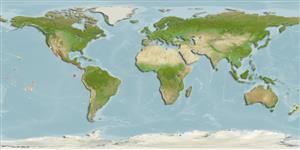Environment: milieu / climate zone / depth range / distribution range
Écologie
marin benthopélagique; profondeur 0 - 50 m (Ref. 9283). Subtropical; 34°N - 18°S, 118°W - 70°W
Eastern Pacific: Redondo Beach in southern California, USA to Peru; rare north of Baja California, Mexico.
Taille / Poids / Âge
Maturity: Lm ? range ? - ? cm
Max length : 40.0 cm TL mâle / non sexé; (Ref. 55763); common length : 24.0 cm FL mâle / non sexé; (Ref. 9283)
Body very short, deep, and compressed; lower branch of first gill arch with 30 to 35 gill rakers; dorsal fin with 8 spines followed by another spine and 21 to 24 soft rays (VIII1, 21-24); anterior lobe of second dorsal and anal fins not elongated in adults; anterior dorsal spines prolonged in juveniles; body scaleless; lateral line scutes very weak and poorly differentiated; body silvery to gold with metallic blue highlights; juveniles silvery, with a dark oval stain on the straight part of the lateral line (ref. 55763).
Adults are found in coastal waters up to at least 50 m depth (Ref. 9283). They generally form schools near the bottom (Ref. 9283). Juveniles are encountered near the surface (Ref. 9283). They feed on small fishes and crustaceans (Ref. 9283). Marketed fresh and salted or dried (Ref. 9283).
Life cycle and mating behavior
Maturité | Reproduction | Frai | Œufs | Fécondité | Larves
Eschmeyer, W.N., E.S. Herald and H. Hammann, 1983. A field guide to Pacific coast fishes of North America. Boston (MA, USA): Houghton Mifflin Company. xii+336 p. (Ref. 2850)
Statut dans la liste rouge de l'IUCN (Ref. 130435)
Menace pour l'homme
Harmless
Utilisations par l'homme
Pêcheries: intérêt commercial mineur
Plus d'informations
RéférencesAquacultureProfil d'aquacultureSouchesGénétiqueElectrophoresesHéritabilitéPathologiesTraitementNutrientsMass conversion
Outils
Articles particuliers
Télécharger en XML
Sources Internet
Estimates based on models
Preferred temperature (Ref.
123201): 20.5 - 28.4, mean 25.1 °C (based on 68 cells).
Phylogenetic diversity index (Ref.
82804): PD
50 = 0.5039 [Uniqueness, from 0.5 = low to 2.0 = high].
Bayesian length-weight: a=0.01738 (0.01092 - 0.02766), b=2.83 (2.70 - 2.96), in cm total length, based on LWR estimates for this species & (Sub)family-body (Ref.
93245).
Niveau trophique (Ref.
69278): 4.3 ±0.5 se; based on diet studies.
Résilience (Ref.
120179): Haut, temps minimum de doublement de population inférieur à 15 mois (Preliminary K or Fecundity.).
Fishing Vulnerability (Ref.
59153): Low to moderate vulnerability (30 of 100).
Nutrients (Ref.
124155): Calcium = 78.7 [38.4, 176.8] mg/100g; Iron = 1.24 [0.61, 2.65] mg/100g; Protein = 17.8 [15.7, 20.2] %; Omega3 = 0.296 [0.153, 0.593] g/100g; Selenium = 25.7 [11.0, 58.5] μg/100g; VitaminA = 17.2 [4.4, 65.3] μg/100g; Zinc = 0.553 [0.352, 0.864] mg/100g (wet weight);
